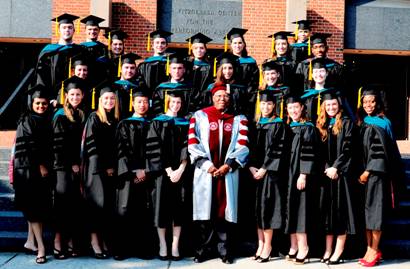The Role of Bodies Donated to Science
Allied health instruction is one the University of Maryland Eastern Shore signature academic programs in the 21st century.

UMES offers a doctoral degree in physical therapy, a credential that is the standard for those who want to practice in that branch of health care.
Between 2005, when the inaugural class of doctoral candidates in physical therapy graduated, and the fall of 2010, every student passed a national exam to receive a recognized certification credential.
That would be impossible, however, without the kindness of people who arrange to donate their bodies to science after they die.
UMES has had a Gross Anatomy Laboratory since the introduction of the Physical Therapy program in 1982. Dr. Werner Seibel, Associate Professor at the Dental School of the University of Maryland at Baltimore, assisted Dr. Raymond Blakely, Chair of the Department of Physical Therapy, with the establishment of the laboratory. When the physical therapy program began, the program was one of the few not associated with a medical center.
The laboratory has changed locations over the years, with its first home in Kiah Hall, then Tanner Hall, and back to Kiah (after its renovation), and then to its current location in Hazel Hall.
Physical Therapy and Physician Assistant students are all required to take a gross anatomy class. For the physical therapy students, cadaver dissection begins in the first year of the curriculum in advanced human anatomy, neuroscience and analysis of human movement. Advanced cadaver dissections continue in the third year in the musculoskeletal course series. Physician Assistant students take one semester of advanced anatomy.
New cadavers are purchased annually from the State Anatomy Board of the Department of Mental Health and Hygiene.
Studying anatomy through cadaver dissection is fundamental for physical therapy and physician assistant students. The process of dissection is a hands-on, kinesthetic learning activity, which enables the students to understand normal anatomy through discovering and appreciating three dimensional relationships.
The knowledge and awareness of three dimensional anatomical relationships are essential for understanding normal anatomy and pathology. Gross anatomy provides the foundation to subsequent coursework within the Doctor of Physical Therapy curriculum.
The cadavers are primarily used for teaching and independent study by physical therapy and physician assistant students and faculty. The laboratory is also utilized for continuing education courses for practicing physical therapists.
In addition, the laboratory is used to educate visiting students from: Anne Arundel Community College’s and Baltimore City Community College’s Physical Therapist Assistant Programs; Wor-Wic Community College’s Emergency Medical Technician program; Salisbury University’s Athletic Training Program and undergraduate students studying Anatomy and Physiology from UMES, Wor-Wic Community College, and Salisbury University.
— Cindy Holder Gill, PT, MEd, Department of Physical Therapy

